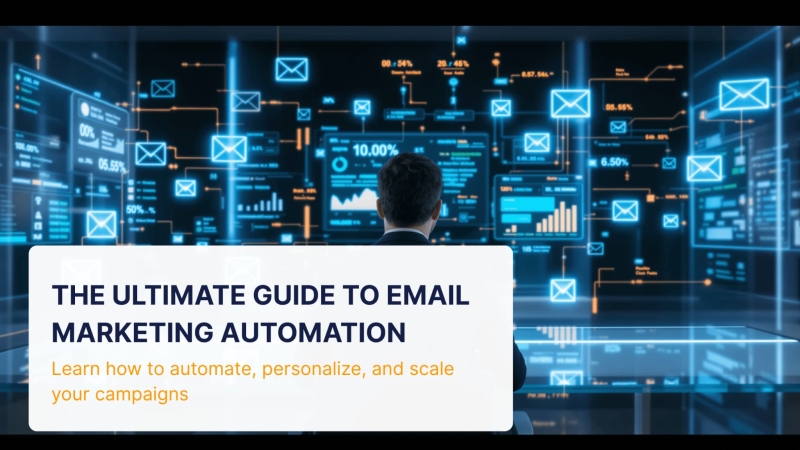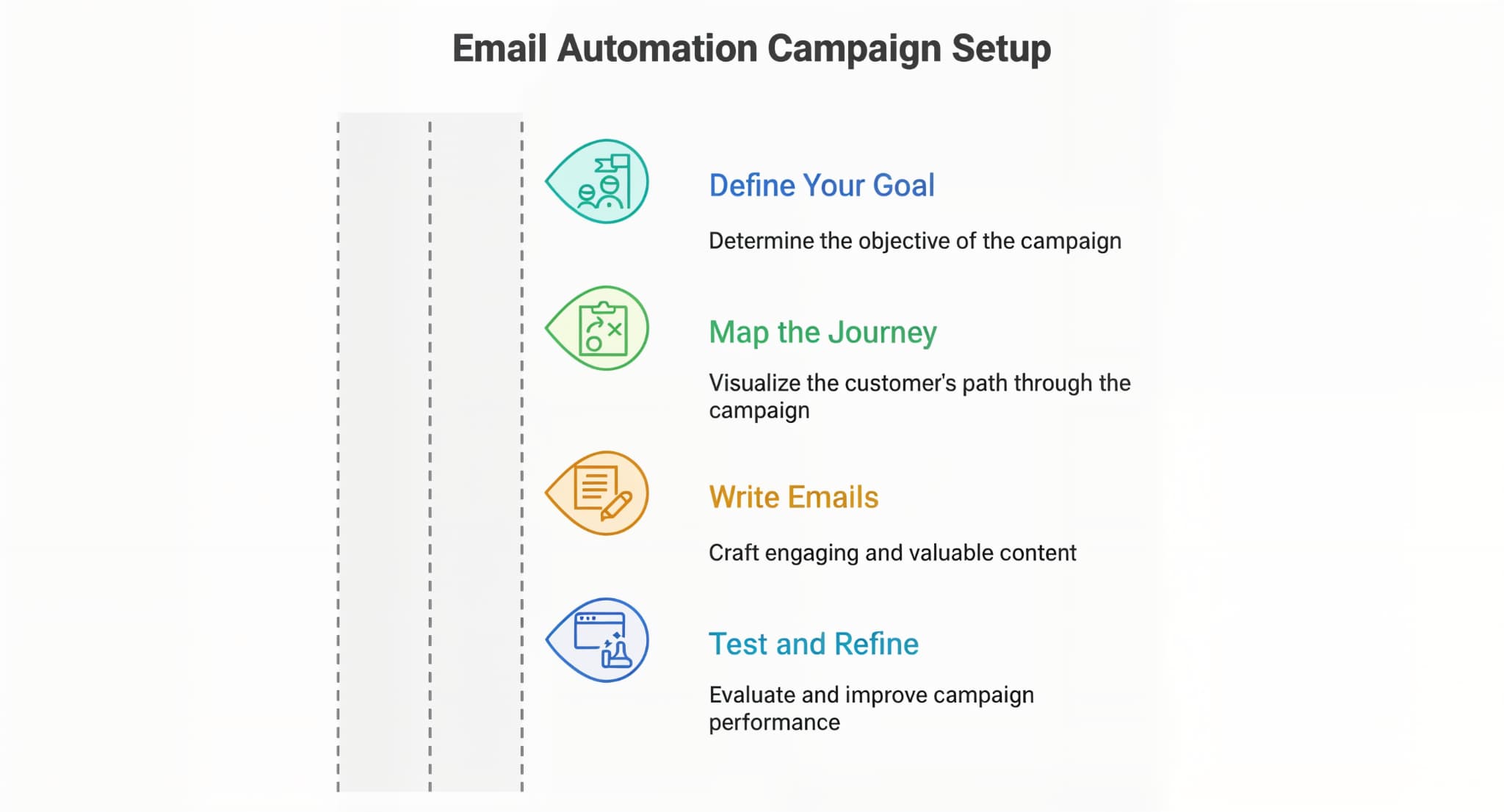The Ultimate Guide to Email Marketing Automation
by

- What Is Email Marketing Automation?
- How Does Email Marketing Automation Work?
- Why Email Marketing Automation Matters
- How to Set Up Your First Email Automation Campaign
- Common Mistakes to Avoid
- Email Marketing vs. Email Marketing Automation
- Real-World Application: Bringing Automation to Life
- Measuring Success
- The Future of Email Automation
- Wrapping It Up
- FAQs
Let’s be honest, email marketing automation isn’t just another shiny marketing buzzword. It’s one of those tools that actually makes your day easier. You know those moments when you wish you could clone yourself to stay in touch with every lead, send every follow-up, and keep every customer engaged? Automation is the next best thing.
Whether you’re just getting started or fine-tuning your setup, this guide walks you through how automation really works, why it’s worth your time, and how to make it feel personal, not robotic.
What Is Email Marketing Automation?
Automation isn’t about replacing the human touch. It’s about keeping that touch consistent. When someone signs up for your newsletter, downloads your guide, or makes a purchase, your system can send the right email automatically, right when it matters most.
Think of it like having a reliable assistant who never forgets. You still decide what to say and when, automation just makes sure it actually happens.
Let’s say you run an online course. You could set up:
- A welcome email with login details right after someone signs up.
- A check-in message two days later, sharing tips for your course.
- A friendly reminder after they complete the course, asking for feedback.
You’ve created a helpful experience without writing new emails every time. Everything feels personal because it’s timely, and timing is everything.
If you want to see real data behind how automation performs, take a look at the Data & Marketing Association’s Email Marketing Tracker. According to their 2024 report, email automation drives an average ROI of 38:1 and boosts engagement rates by over 25% compared to manual campaigns. These insights show how consistent, timely messaging keeps audiences connected and conversions growing.
Let Us Help You Get Started!
Pulse CRM delivers more than software. We’re your partner in success.
We fully set up your CRM, including importing your data, configuring sales and marketing automations, designing branded email templates, writing engaging email copy, setting up sales pipelines, and much more.
How Does Email Marketing Automation Work?
Let’s break this down. Every automation works through triggers and actions, think cause and effect.
- Trigger: A subscriber downloads your free guide.
- Action: They automatically receive a follow-up email with more resources.
And it keeps going:
- They click a specific link in your email. Great! Send them a webinar invite.
- They skip it. No problem, send a softer check-in next week.
That’s how automation feels human. It adapts to behavior. The system pays attention to what your audience does, not just what you hope they’ll do. Over time, you’ll start to see patterns, what’s working, what’s not, so you can fine-tune your approach.
You can learn more about designing workflows like this by exploring real examples of automation sequences and applying the same structure to your own campaigns. It’s a simple, effective way to connect all the moving pieces and keep your customer experience seamless.

Why Email Marketing Automation Matters
You already have too much on your plate. Automation takes repetitive tasks off it, and it does it in a way that keeps your customers engaged and appreciated.
1. Drives Revenue and Retention
Imagine this scenario. Someone browses your product page but doesn’t buy. A day later, they get an email that says, “Still thinking about it? Here’s how others are using this.” It’s subtle, helpful, and effective.
That’s the power of automation. It helps you show up with the right message at the right time. People feel remembered, not sold to. That’s how loyalty grows.
2. Personalizes the Experience
You’ve probably opened an email that felt written just for you. That’s automation done right. By using data from your CRM, you can tailor messages to match people’s interests, location, or past actions. It’s not about sending more emails, it’s about sending better ones.
3. Saves Time and Keeps Things Consistent
Instead of juggling spreadsheets or missing reminders, automation does the work for you. You set it once, and it keeps running. That consistency builds trust and makes your brand feel organized and reliable.
4. Gives You Real Insight
With each campaign, you learn something new. Which emails get opened? Which ones spark replies? Use that information to adjust, improve, and grow. The data is your feedback loop.

How to Set Up Your First Email Automation Campaign
How to Set Up Your First Email Automation Campaign
Alright, you know why automation works, so let’s get into how to actually build one. This doesn’t have to be overwhelming; it’s like planning a small road trip rather than mapping out an entire cross‑country journey.
Step 1: Define Your Goal
Start with one simple question: What do I want this campaign to do?
- Are you welcoming new subscribers?
- Are you nurturing leads who haven’t yet bought?
- Or are you re‑engaging quiet customers? Once that’s clear, everything else flows. Your goal becomes the compass that guides every email you write.
Step 2: Map the Journey
Think about how someone moves from point A to point B.
- Trigger: What starts the workflow (a form submission, download, or purchase)?
- Touchpoints: What happens next and what happens after that?
- Outcome: What’s the finish you’re aiming for, a demo booked, a purchase made, a form completed? Mapping this out visually helps you spot gaps or dead ends. And if you’re using a tool like Pulse CRM with built‑in workflows, the mapping process becomes more intuitive.
Step 3: Write Emails That Help, Not Sell
Remember, you’re talking to a real person, not blasting a list.
- Use a friendly tone, “Here’s what happens next…” rather than “Buy now!”
- Focus on value, teach, guide, or support rather than hard‑sell.
- End each email with one clear next step, a link, a reply, or a download. If you need inspiration on what to send, check out Best Practices for Lead Nurturing with Automation for ideas.
Step 4: Test and Refine
Complete the setup and go live, but don’t walk away.
- Test subject lines, send times, and email frequency.
- Watch key metrics (open rate, clicks, conversions) and ask: What changed?
- Make small tweaks such as changing wording or segmenting your audience differently.
If you’re curious what top‑performing campaigns do, independent research by the Data & Marketing Association shows that automated emails can produce over 100% higher click‑through rates and increase lead nurturing efficiency by nearly 50%. These benchmarks highlight how consistent, well‑timed automation can significantly improve engagement across industries.
Now that your first workflow is ready, tune it periodically and expand it over time. Remember, you’re building one smart process now that supports many users later.

Common Mistakes to Avoid
Every marketer has tripped up on automation at least once. It’s not about being perfect; it’s about learning what to watch for so your emails always hit the mark. Watch out for these common mistakes so you can stay ahead of the curve and build smarter, more thoughtful workflows.
- Too many emails: Flooding inboxes can turn interest into frustration fast. It’s better to space your messages out and make each one count. Quality beats quantity.
- Outdated workflows: Your business changes, and your automations should evolve too. Imagine promoting last year’s offer or using outdated branding. It confuses your audience. Schedule regular audits every three to six months to refresh content, links, and visuals. This keeps your communication relevant and professional.
- No segmentation: Sending the same email to everyone is like addressing a crowd with a megaphone. Instead, group your contacts based on behavior or their current stage in the customer journey. For instance, someone who downloaded a free guide needs different follow-up emails than a returning customer. Using segmentation ensures each message feels personalized and purposeful. Learn more about tailoring messages in Best Practices for Lead Nurturing with Automation.
- Ignoring the data: Data is your best feedback. If clicks are dropping, something needs to be tweaked. Reviewing metrics weekly helps you spot trends before they become problems. Pulse users often find that small changes, like changing your CTA, can boost conversions by 8–11%.
- Sounding robotic: Even the best automation loses impact if it feels cold. Write your emails as if you’re speaking directly to one person. Add a name, a natural tone, and small personal touches.
The key takeaway? Automation works best when it’s human at its core. When every message feels like it was written for someone personally, you build connection, trust, and momentum.
Email Marketing vs. Email Marketing Automation
Here’s a quick look at how traditional email marketing compares to automation and why the combination is so powerful.
| Aspect | Email Marketing | Email Marketing Automation |
|---|---|---|
|
Definition |
You manually create and send each campaign. |
You set up workflows that send based on triggers. |
|
Purpose |
Great for one-time updates or promotions. |
Ideal for long-term nurturing and follow-up. |
|
Setup Effort |
Quick to send but repetitive. |
Takes setup time, then runs itself. |
|
Personalization |
Limited, maybe a name or location. |
Deeply personalized, based on actions and timing. |
|
Scalability |
Becomes overwhelming as your list grows. |
Effortlessly scales to thousands of contacts. |
Automation doesn’t replace manual emails; it complements them. You’ll still send newsletters and updates, but automation makes sure nobody falls through the cracks.
Let Us Help You Get Started!
Pulse CRM delivers more than software. We’re your partner in success.
We fully set up your CRM, including importing your data, configuring sales and marketing automations, designing branded email templates, writing engaging email copy, setting up sales pipelines, and much more.
Real-World Application: Bringing Automation to Life
Let’s ground this in a real example. A small fitness brand used Pulse CRM to set up a welcome series. Here’s what happened:
- A welcome email went out instantly after sign-up.
- Two days later, a “how to get started” email with quick tips.
- A week in, a success story from another customer.
- Finally, a personalized offer for a paid program.
Within a month, their engagement rate doubled. Why? Because every email felt personal, timely, and helpful.
That’s what good automation does. It helps you show up in the right moments. If you want to see how workflows can work for you, visit marketing automation to learn more.

Measuring Success
Data doesn’t have to be intimidating. Think of it as feedback from your audience, a way for them to tell you what’s resonating and what’s missing. When you understand your numbers, you can make confident, strategic adjustments that drive better results.
Start by tracking the essentials:
- Open rates show how well your subject lines grab attention.
- Click-through rates (CTR) reveal what content inspires curiosity or action.
- Conversions tell you whether your emails are truly motivating people to take the next step.
But here’s where it gets practical: don’t just collect data, act on it. For example, a growing online retailer reviewed their email analytics and noticed a pattern: open rates were solid, but link clicks lagged. After experimenting with simpler CTAs and shorter copy, they saw CTR improve by 5% within a month. The lesson? Small, data-driven tweaks make a big difference over time.
If your CRM provides visual reports (like Pulse does), use those insights to pinpoint where subscribers drop off or engage most. Segmenting your performance data by audience type or campaign goal also reveals where your strategy is strongest and where you can fine-tune. Over time, you’ll see not just higher engagement, but clearer trends that guide smarter business decisions.
To keep your analysis consistent, set a monthly review cadence. Ask yourself:
- What’s performing above average and why?
- Which workflows or sequences underperform?
- What small experiments can I run next month?
When you track, test, and adjust regularly, your automation stops being a set‑it‑and‑forget‑it tool and becomes a living, improving system. To learn more about optimizing performance, explore Best Practices for Lead Nurturing with Automation.

The Future of Email Automation
So, what’s next? Automation is getting smarter, not colder. With AI and CRM systems working together, emails are becoming more predictive, intuitive, and even emotionally aware. The goal isn’t to replace human marketers, it’s to make your communication feel more natural, even at scale.
Here’s what’s coming:
- Smarter timing: Algorithms are already learning when each contact is most likely to engage. Soon, sending will be completely optimized per person, not per list.
- Dynamic personalization: Future campaigns will go beyond names. Think product recommendations, unique stories, or tailored messages that adjust based on preferences and behaviors in real time.
- Cross-channel experiences: Automation is already moving beyond email, evolving into smarter, multi‑platform systems that work seamlessly across channels. Imagine workflows that not only coordinate email, text, and social, but also use AI to predict when and where your audience is most likely to engage. Soon, marketers will be able to deliver personalized content across devices and even emerging platforms like voice assistants or connected apps, all driven by data and context rather than guesswork.
This evolution matters because it brings brands closer to their customers without adding more manual effort.
The future of automation isn’t about doing more; it’s about doing better. By blending technology with empathy, marketers can create meaningful, scalable connections. For more insights on adapting to this shift, check out the latest strategies on the Pulse Blog.
Wrapping It Up
Here’s the takeaway. Automation doesn’t replace your voice; it amplifies it. It gives you the breathing room to focus on creating experiences that matter.
Start small. Build one workflow. Refine it. Watch it grow. Before you know it, you’ll have a system that runs smoothly and builds stronger relationships at every step.
Ready to put it into practice? Set up your first automated workflow today and experience how much simpler it is to stay consistent, thoughtful, and aligned with your brand. Want a more personalized plan? Book a free strategy session to discover how Pulse can power your email marketing automation and let our team help you set it up step by step.
FAQs
Manual campaigns are one-time sends you schedule yourself, while automated campaigns run on pre-set triggers, sending the right message automatically when someone takes action. The difference really comes down to timing and consistency. With automation, your audience hears from you exactly when it’s most relevant, like right after signing up or completing a purchase. For example, a small business could send a welcome email immediately after someone downloads a guide, while a manual campaign would require a team member to remember and send it later.
Keep an eye on engagement metrics like opens, clicks, and conversions. But numbers only tell part of the story; you also need to pay attention to trends. If people consistently open your first email but ignore the second, you might need to adjust timing or tone. Pulse CRM makes this simple by showing performance at each step of your workflow so you can improve quickly and confidently.
Absolutely. Small teams often get the biggest payoff because automation saves time while keeping communication personal and timely. Think of it as a digital assistant who never forgets to follow up or check in.
Review your workflows every few months or when something in your business changes, like new products, pricing, or messaging. Outdated emails can hurt credibility or miss opportunities. Regular updates help ensure your content still matches your audience’s needs. For example, if you used to promote free trials but now offer demos, update your emails to reflect that shift.
The best tools are the ones that make automation feel effortless and integrated with the rest of your business. Platforms like Pulse CRM help you manage campaigns, track behavior, and build workflows all in one place. This means you can handle emails, contacts, and analytics without jumping between apps. Whether you’re just starting or scaling, having everything under one roof keeps things consistent and efficient.


